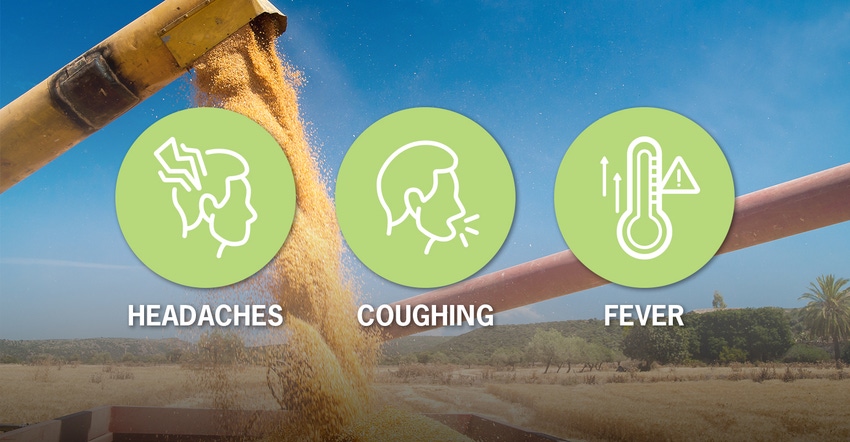Keeping workers safe and facilities in compliance
September 1, 2021

Sponsored Content
Many grain mill, silo and seed processing plant operators don’t realize the dangers of airborne grain particles. Applications like corn shelling, seed cleaning, seed preparation and seed coating produce dust, and it is also produced when grains are moved and stored. These dust particles often become airborne, which can threaten employee health and cause combustible dust incidents. Dust particles vary in size, and some are so fine they are not visible to the naked eye. This article discusses these dangers, applicable regulatory guidelines and how high-efficiency dust collection systems can help keep workers safe and facilities in compliance.
Occupational Exposure
Regular exposure to certain types of fine dust particles can produce minor allergic reactions on the skin such as dermatitis. Such conditions are uncomfortable for workers and require treatment and protective work wear, which can affect an employee’s performance and well-being. However, the respiratory distress that dust allergens can cause is far more serious. The finest dust particles readily become airborne and are easily inhaled, penetrating deep into the lungs. They can cause life-threatening conditions such as occupational asthma as well as chronic, long-term health issues including lung cancer. OSHA regulations govern employers whose processes generate dust. Facilities must control dust emissions into the indoor workplace atmosphere to comply with legal limits set for a particular material.
Cross-Contamination
Food contamination and foodborne illness cause recalls that cost food manufacturers hundreds of millions of dollars. Traveling dust in a processing facility can cause a pathogen outbreak from the spread of microorganisms or allergen exposure. Preventing cross-contamination requires effectively collecting and removing all contaminants before they become widely dispersed.
Combustible Dust Explosions
A dust explosion occurs when a confined and concentrated combustible dust cloud comes into contact with an ignition source. Many seed and grain processes produce explosive dusts. Good housekeeping and installing a well-designed dust collection system can prevent airborne dust from building up in the work environment to negate the risk of a primary or secondary explosion. However, an unprotected dust collector can be a primary cause of combustible dust explosions.
Controlling Worker Exposure to Dust
The primary regulations for occupational exposure and cross-contamination are: Occupational Safety and Health Association (OSHA) 1910, Food and Drug Administration (FDA) Food Safety Modernization Act, US Department of Agriculture (USDA) Food Safety and Inspection Service.
The best way to reduce workers’ exposure to and cross-contamination from hazardous dusts is to install dust collection systems with high-efficiency primary and secondary cartridge-style filters. Primary filter media should be selected for each application based on the dust particle size, flow characteristics, quantity and distribution. If the primary filtration system does not use a HEPA filter, it is recommended that a secondary HEPA filter be used downstream. Secondary filters prevent hazardous dusts from discharging into the atmosphere and can be configured to prevent return air ducting contamination and the associated costs of cleaning hazardous dust leakage.
A wide, uniformly pleated filter allows the collected dust to release from the filter, keeping the resistance lower through the filter for a longer time. High-efficiency dust collection systems also use self-cleaning mechanisms that regularly pulse dust off the filters, allowing units to run longer between filter change-outs.
Mitigating Combustible Dust
It is critical to know the explosive potential of the dusts produced when processing grains and seeds. The regulations and standards governing combustible dusts come from OSHA and the National Fire Protection Agency (NFPA). NFPA requires a hazard analysis is needed to assess risk and determine the required level of fire and explosion protection from combustible dust. The analysis can be conducted internally or by an independent consultant, but either way the authority having jurisdiction will ultimately review and approve the findings.
The first step in a hazard analysis is determining whether your dust is explosive. NFPA classifies dusts according to their explosibility ( Kst value), which is the normalized maximum rate of explosion pressure rise, measured in bar m/s. If OSHA determines that even a very low Kst dust is present in a facility with no explosion protection in place, they will issue a citation.
In addition to Kst, it is important to know Pmax (the maximum explosion pressure of a dust cloud, measured in bar). Your dust collection equipment supplier need the Kst and Pmax values in order to correctly size explosion venting or suppression systems. It is also important to analyze other dust characteristics like particle size, dust shape, gravity and moisture level to determine the best dust collection system and filters for your operation.
Dust Collectors and Explosion Protection
Combustible dust explosions are a risk in many areas of grain and seed processing facilities, but one of the most common locations is the dust collection system itself. There are many types of devices and systems used to protect dust collectors so that they comply with NFPA standards. Major systems include:
Explosion Venting
Designed to be the “weak link†of the dust collector vessel, an explosion vent opens when predetermined pressures are reached inside the collector, allowing the excess pressure and flame front to exit to a safe area. It is designed to minimize damage to the collector and prevent it from blowing up in the event of a deflagration, thereby reducing the safety hazard.
Flameless Venting
Designed to install over a standard explosion vent, a flameless vent extinguishes the flame front exiting the vented area, not allowing it to exit the device. This allows conventional venting to be accomplished indoors where it could otherwise endanger personnel and/or ignite secondary explosions.
Seed and grain storage and processing facilities are morally and legally bound to control the dangerous dusts they produce. These dusts can cause serious harm to employee health, reduce product quality, and cause devastating explosions that can hurt or kill workers and bring irreparable damage. A high-efficiency dust collector designed specifically for your operation is an accepted and proven engineering control that will filter hazardous contaminants to make indoor environments safer.
About the Author(s)
You May Also Like

.png?width=300&auto=webp&quality=80&disable=upscale)

